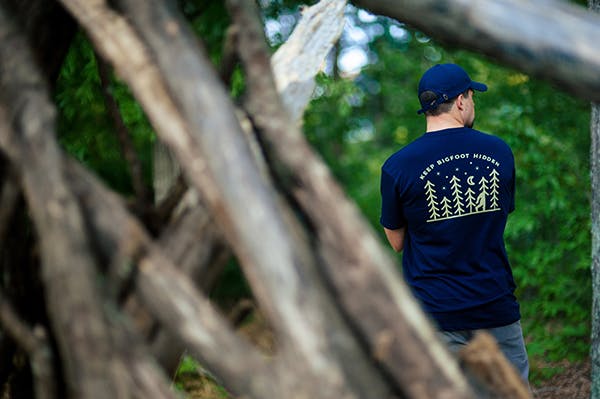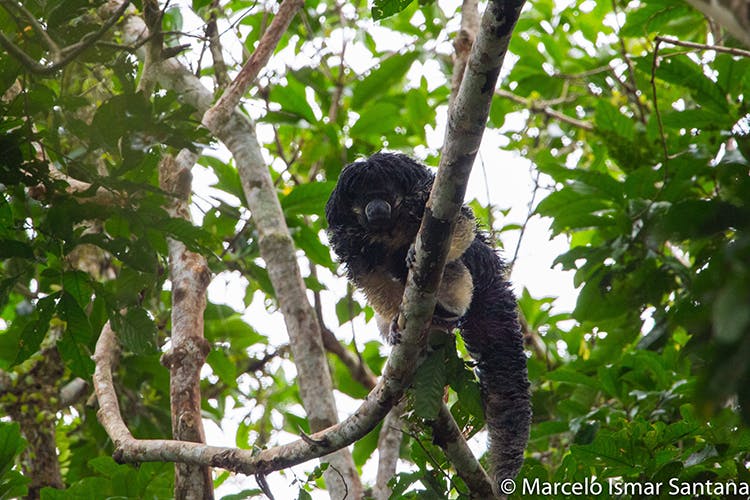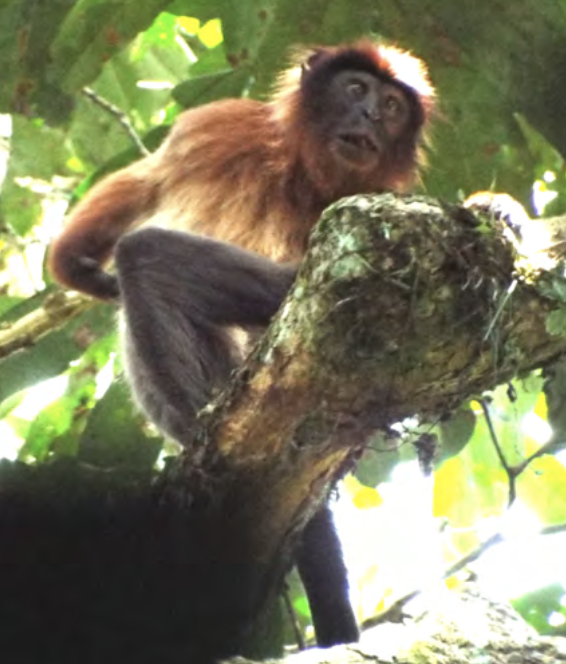 BACK TO NEWS
BACK TO NEWSYeti and Bigfoot: Are they real?
A look at the dual legends of the Yeti (Abominable Snowman) from the Himalayas and Bigfoot (Sasquatch) from the northwestern United States and Canada
By Russ Mittermeier on April 01, 2022 
The legends of Yeti and Bigfoot have been around for decades – even centuries, and I remember my early exposure to the Yeti story following the first ascent of Mt. Everest (Sagarmatha) by Tenzing Norgay and Sir Edmund Hillary on May 29, 1953. I was almost four years old then and, as a budding primatologist, completely fascinated by the possibility that such a fantastic animal might exist. Norgay and Hillary saw and photographed huge footprints crossing a snowfield in the high Himalayas (which had actually been reported earlier in a 1951 reconnaissance expedition, but it was the Mt. Everest expedition that truly brought it to the world’s attention), and it created quite an international stir. Not to be outdone, in the United States, we resurrected the ancient Northwest Native American legend of Sasquatch, baptizing it “Bigfoot” based on a plaster cast of a very large footprint taken in 1967 in Bluff Creek, in northern California.
Interest in these two legends has waxed and waned over my lifetime, but it has always been kept alive by what are called “cryptozoologists,” people who avidly follow the stories of the Loch Ness Monster in Scotland, the Mokele Mbembe in the Congo, and the Orang Pendek in Sumatra. I even know a Harvard-trained, world class Ph.D. ornithologist who spent a good five years of his life trying to track down the legendary Mapinguari in Brazil and neighboring Amazonian countries. These are the hard-core people who want so much to discover new and wonderful species unknown to science. And I certainly don’t want to take anything away from them because I myself have long been interested in the discovery of new species since the earliest days of my career. Indeed, I have discovered or been closely involved with the description of 21 species new to science and have eight more named after me (two lemurs from Madagascar, an Amazonian Saki monkey, three frogs, a lizard and an ant). I have closely followed some of the great discoveries of species since the beginning of the 20th century, among them:
the Okapi (also known as zebra giraffe) from the Congo (discovered in 1901, but mentioned by the famous African explorer Henry Morton Stanley as early as 1890)
the Mountain Gorilla from the Virunga Volcanoes on the border between the Democratic Republic of Congo, Uganda and Rwanda (1902)
the Bonobo ape (our closest living relative), again from the Democratic Republic of Congo (1929)
the Saola (the “Asian unicorn”) from Indochina (1992)
the Tapanuli Orangutan from central Sumatra (2017)
We still have much to learn of our planet’s biodiversity, and new species are being discovered by the hundreds every year, not to mention the Search for Lost Species, which is an important theme for Re:wild (and what better Lost Species could there be than the Yeti?).
That said, this recent upsurge of interest in both the Yeti and Bigfoot over the past couple of years has been impressive, and a little hard to explain, other than perhaps attributing it to our never-ending quest for knowledge and our desire to explore new worlds. There are at least four different television series focused on Bigfoot, and not just in the Pacific Northwest but all over the U.S., and there have been a couple of very interesting programs exploring the legend of the Yeti, one focused on Russia (“Russian Yeti: The Killer Lives”), one on “Expedition Unknown” with Josh Gates (“Search for the Yeti”), and one in the Himalayas of Nepal and Tibet (“Hunt for the Yeti”). The quality varies, but a lot of time and investment has gone into them, and the recent Yeti program, “Expedition Bigfoot”, featuring my friend Dr. Mireya Mayor on the Travel Channel presented some very interesting results.
"This recent upsurge of interest in both the Yeti and Bigfoot over the past couple of years has been impressive, and a little hard to explain, other than perhaps attributing it to our never-ending quest for knowledge and our desire to explore new worlds."
- Russ Mittermeier

Bear…or Ape?
Back in 2005, I even did a program on the search for the Yeti, in collaboration with television wildlife celebrity Jeff Corwin, and with Disney and the Discovery Channel. This was stimulated by the Disney Animal Kingdom’s new attraction entitled “Expedition Everest,” which featured the Yeti as its main character. I was at the time a member of the Advisory Board for the Animal Kingdom, and was enlisted by them to participate in this program. We traveled to Nepal, in particular the Tengboche region at an altitude of about 4,000 meters, and also to the Qinling Mountains in China’s Xian Province to film the spectacular Golden Monkeys (Rhinopithecus roxellana qinlingensis), a very large primate that would in all likelihood coexist – or have coexisted – with the Yeti in some places.
During this trip, we visited several monasteries to examine supposed Yeti relics, and also interviewed monks and villagers to hear their stories. The results were fascinating. Although I was not impressed by the relics, one supposed scalp of a Yeti looked like it was made either of domestic goat or wild goral hair, and some of the bones looked more like bear than primate. However, some of the stories that we were told were quite enlightening.
Prior to embarking on this expedition, I read Reinhold Messner’s book "My Quest for the Yeti: Confronting the Himalayas’ Deepest Mystery". Messner is one of the greatest mountaineers in history, having been the first to do a solo ascent of Mt. Everest without oxygen, and having climbed all of the world’s peaks above 8,000 meters. A very serious German who was not prone to hyperbole, I was more inclined to listen to what he had to say in contrast to many other “experts.” Messner had one encounter with a “Yeti” on a dark night and was convinced that it was a bear. Indeed, he believes that the current legend of the Yeti is based on the very rare Tibetan Brown Bear or its close relative the Himalayan Brown Bear. Both of these huge animals are closely related to Alaskan Brown Bears and Grizzlies, but they are extremely rare in the Himalayas, in contrast to Brown Bears and Grizzlies in Alaska, where they are still relatively abundant.
Messner also floated the idea that the bear in question might be a hybrid between a Polar Bear and a Brown Bear, which could account for its high levels of aggression in many of the first-person accounts of encounters. However, research covered by Mark Evans in the program “Hunt for the Yeti,” which collected hair and bone samples from various sites and relics, did not find evidence of Polar Bear DNA. Indeed, all but one of the samples was of the Tibetan Brown Bear, with one being of the Asiatic Black Bear, which does not occur in the region, indicating that the relic was probably transported from elsewhere. I don’t believe that you need Polar Bear genes to account for aggression in Brown Bears, since they can also be quite aggressive without any help from Polar Bears.
One interview that Jeff Corwin and I conducted in the Tengboche area also linked the Yeti with the Brown Bear. We spoke at length with a woman who had been attacked by a “Yeti,” and her description coincided very well with other bear attacks. When we asked her if she knew what a bear was, she replied that she did not.
However, like me, Messner also believes that the oral tradition of the Yeti is based on a real-life giant ape that existed in Asia between 2.6 million and 100,000 years ago, which means that it could easily have overlapped with early humans like Homo erectus in this part of the world – and it could have survived even longer and overlapped with modern Homo sapiens. This was the aptly named Gigantopithecus blacki that shared a common ancestor with the modern Orangutan about 10-12 million years ago, and was first discovered by the German-Dutch paleontologist G, H, R, von Koenigswald, who between 1935 and 1939 found enormous molar teeth being sold as “dragon’s teeth” in Chinese drugstores. This amazing species was by far the largest primate that ever lived, dwarfing modern gorillas and reaching a height of about 3 meters (9.8 feet) and weighing 200-300 kg (440-660 pounds). Imagine the impression such an animal could have made on early humans and how it could have entered strongly into their oral traditions, easily giving rise to the legend of a giant ape-like being today known as the Yeti and a variety of other local names.
What’s more, during our interviews with local people, one very senior monk in Tengboche told us that the Yeti moved on the ground and had long flowing red hair dragging along behind it. Sound familiar? Modern male Orangutans, the largest arboreal animals, have very long red hair and regularly come down to the ground to move between trees since they are so heavy that sometimes they can’t easily traverse between trees. Although today’s Orangutans are found only on the islands of Borneo and Sumatra, they were found on mainland Asia up to the foothills of the Himalayas as recently as 10,000 years ago. They unquestionably overlapped with humans, so it is not too hard to imagine very early oral traditions of Gigantopithecus combining with those based on the Orangutan to yield a fantastic ape legend.

Meanwhile, in North America…
That explains to some extent the possible origins of the legend of the Yeti in Asia. What about the very similar stories of a giant ape in the Pacific Northwestern United States and Canada, where there are no fossil remains of giant apes? One perfectly plausible explanation is that the multi-generational legends of giant apes originating in Asia came with early humans that crossed the land bridge over what is now the Bering Strait some 12,000 years ago. Given that huge bears occurred in the lower 48 and still are relatively abundant in Alaska and Canada, the Yeti legend could once again have been fortified by and hybridized with the primate origins of the Yeti legend. At that time, there existed a very intimidating Short-Faced Bear that certainly overlapped with early humans and disappeared less than 10,000 years ago.
It is also worth noting that local people in many parts of the Himalayas take the Yeti legend very seriously and continue to tell many stories about it. The country of Bhutan has even established a Yeti National Park to protect part of the legend’s remaining natural habitat!
That said, if these apes are now gone (the Orangutans certainly are no longer on the Asian mainland) and people are regularly reporting sightings and encounters with Yetis, what is it that they are seeing?
Skeptic or believer?
I remain a skeptic about both the Yeti and Bigfoot, but I give the Yeti a better chance of being real. The terrain in the Himalayas is often so steep that you can’t walk more than a few steps before having to crawl. The forests are very dense and could harbor a giant ape, as they continue to harbor tigers, leopards, Takin and other large animals to the present day. And, of course, these animals must have been forest dwellers, and not inhabitants of vast snowfields with almost no food for a large plant-eating primate. If the footprints in the snow seen by Norgay, Hillary and others were in fact those of the Yeti, it must have been in transit between patches of forest and not permanently residing in the snow.
What makes me most skeptical about the existence of either legend is that no recent remains of giant apes have been found. A large animal like this would certainly leave behind bones, teeth, and other body parts upon death, and these are more likely to persist in the higher altitude temperate forests than in a tropical rain forest. Yet nothing has been found, and every hair sample that has been analyzed is either a bear, a wild ungulate (hoofed mammal) of some kind, or even a domestic animal. I would love to see just one bone clearly attributable to a large primate, and I would immediately become a believer.
That said, knowing what I do about so many unique and previously unknown species that have been found in my lifetime and how many more are still out there, I continue to believe that there is perhaps a chance that we will finally discover a giant ape. I would give it less than 1% but not zero. And, if I am not the one to do it, I would want be one of the first to travel to see it with my own eyes. What an amazing tick on a primate-watcher’s life list that would be! But more importantly, the first thing that I would want to do is work with colleagues to create a plan for the survival of such a wonderful species. All of the currently known subspecies of great apes—four different kinds of chimpanzees, the Bonobo, four gorillas, and five orangutans—are all considered either endangered or critically endangered, and we have a major task ahead of us to ensure that they remain with us. A real-life Yeti or Bigfoot (or whatever we would want to call it) would certainly deserve at least as much attention, and would almost certainly immediately enter into the Critically Endangered category. Let’s not give up hope for finding these wonderful, perhaps fanciful, animal. Let’s continue to devote the vast majority of our attention and resources to ensuring the survival of those that definitely still exist.
"It is also worth noting that local people in many parts of the Himalayas take the Yeti legend very seriously and continue to tell many stories about it. The country of Bhutan has even established a Yeti National Park to protect part of the legend’s remaining natural habitat!"
- Russ Mittermeier
Russ Mittermeier is the Chief Conservation Officer of Re:wild and the long-time Chair of the IUCN Species Survival Commission Primate Specialist Group. He has been studying primates for more than 50 years, and has helped develop and promote the concepts of primate ecotourism, primate-watching and primate life-listing. In 2019, he became the first person in history to see all 80 genera of primates in the wild.

Bigfoot Kick is an apparel brand that draws inspiration from hip-hip, video game, and adventure cultures, collaborating with diverse artists to create an immersive world of wonder and imagination in limited-batch, sustainably-minded collections. Inspired by the individualistic expression of streetwear and the natural beauty of our world, Bigfoot Kick ignites our curious nature to search for what we believe in.
And look fly while doing it.
For the month of April, 10% of each purchase supports Re:wild's efforts to protect and restore the wild. Bigfoot Kick is also offering $10 off your purchase of $20 or more. 👣
About the author
Russ Mittermeier
Dr. Russ Mittermeier is Re:wild’s Chief Conservation Officer. In this role, he leverages his extensive experience and network to protect wildlife and wildlands—enormous reservoirs of biodiversity and key components in preventing runaway climate change— particularly in biodiversity hotspots and critical wilderness areas. Mittermeier was previously with Conservation International, where he served as president from 1989 until 2014, and most recently as executive vice chair. He also chairs the IUCN/SSC Primate Specialist Group.


